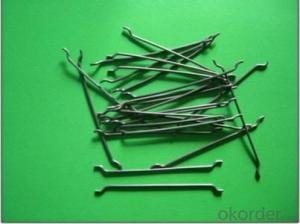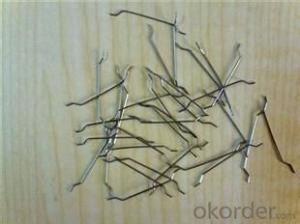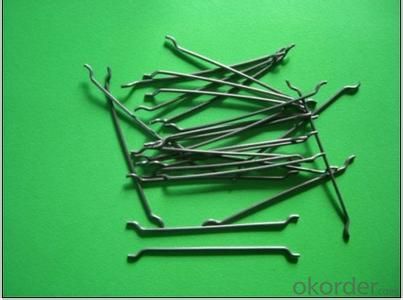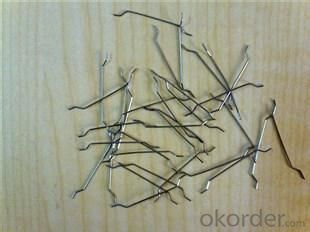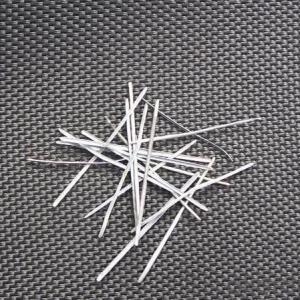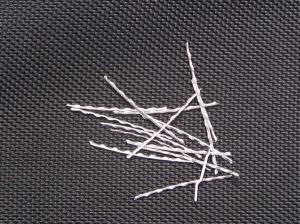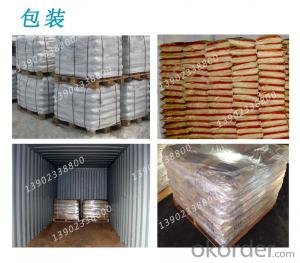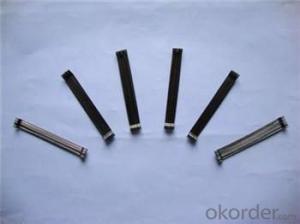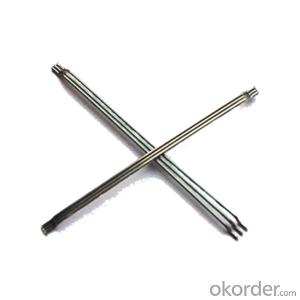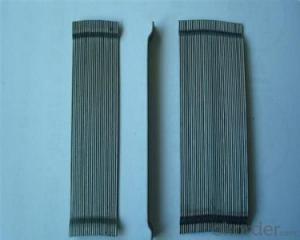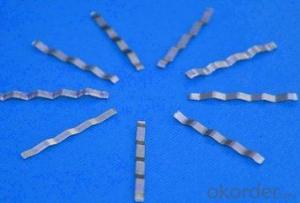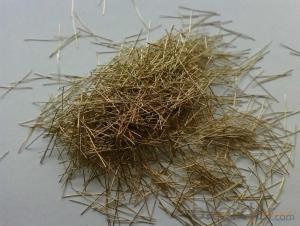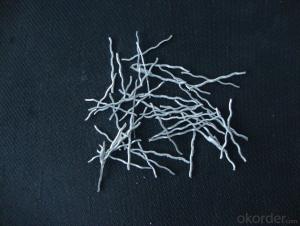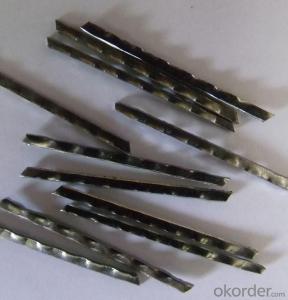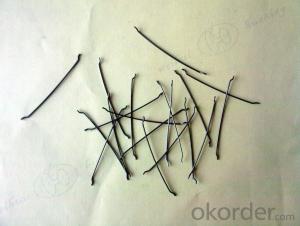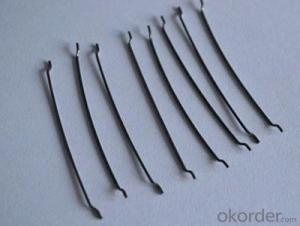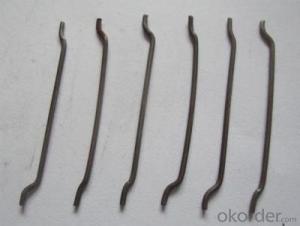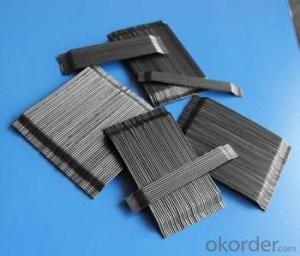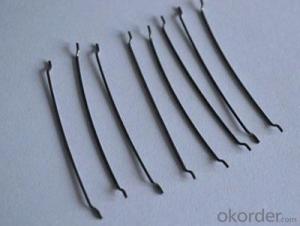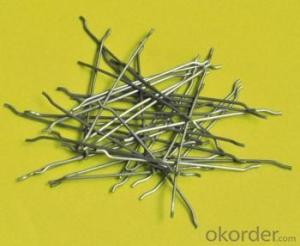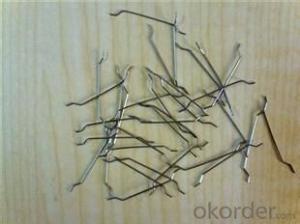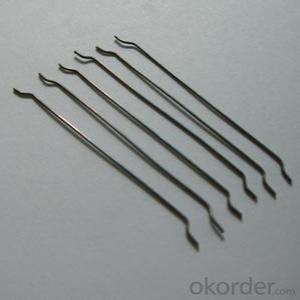Melt Extract Stainless Steel Fiber - Steel Fiber Copper Coated Company from CNBM
- Loading Port:
- Tianjin
- Payment Terms:
- TT OR LC
- Min Order Qty:
- 2000 kg
- Supply Capability:
- 30000 kg/month
OKorder Service Pledge
OKorder Financial Service
You Might Also Like
Quick Details
Place of Origin: Jiangsu, China (Mainland)
Model Number: HT-ST
Material: Steel
Specifications
ISO 9001 certificated
2.70% for Europe, Middle Asia, America market
3.Have the most number of steel fiber machine in china
1. Material: low carbon steel wire or stainless steel
2.Diameter: 0.4mm-1.0mm
3.Length: meet your requirements
4.tensile strength >1000Mpa
6.Feature: excellent tensile,high tenacity,against cracking,impact and fatigue
7.Uses: highway road surface,tunnel,building,airport road surface and so on .
Straight Steel Fiber
1.ISO 9001 certificated
2.70% for Europe, Middle Asia, America market
3.Have the most number of steel fiber machine in china
Picture
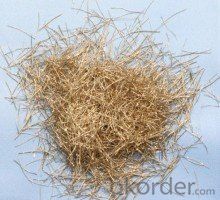
Steel fiber
FAQ
certificated: ISO 9001
Technical advantages of Daye steel fiber:
A. Improve mechanical performance of concrete
B. Provide uniform distribution throughout concrete with excellent mixing
C. No balling or caking by adopt correct mixing method
D. Reduce concrete volume
E.Save construction time and cost
F.Reduce excavation volume
G.Available for jointless floor.
- Q: Can melt extract stainless steel fiber be used in sports field pavements?
- Yes, melt extract stainless steel fiber can be used in sports field pavements. Stainless steel fibers are known for their high strength and durability, making them an excellent choice for applications that require resistance to wear and heavy traffic, such as sports field pavements. These fibers can improve the overall performance and lifespan of the pavement by enhancing its toughness, crack resistance, and fatigue resistance. Additionally, the corrosion resistance of stainless steel ensures that the fibers will not deteriorate over time, even in harsh weather conditions. Overall, using melt extract stainless steel fiber in sports field pavements can help create a more robust and long-lasting surface that can withstand the rigorous demands of sports activities.
- Q: Can melt extract stainless steel fiber replace traditional steel reinforcement in concrete?
- Certain applications can see the substitution of traditional steel reinforcement in concrete with melt extract stainless steel fiber. Melt extract stainless steel fiber presents various advantages over traditional steel reinforcement, including increased durability, enhanced crack resistance, and improved corrosion resistance. These fibers, made from stainless steel, are typically incorporated into the concrete mixture during the mixing process. They contribute additional strength and support to the concrete, reducing the reliance on traditional steel reinforcement like rebar or mesh. One of the primary benefits of melt extract stainless steel fiber is its ability to enhance the durability of concrete structures. By evenly distributing stress throughout the concrete, the fibers decrease the likelihood of cracks and improve the overall strength of the structure. This aspect proves especially valuable in applications where the concrete will experience heavy loads or extreme conditions. Another advantage is the improved crack resistance offered by melt extract stainless steel fiber. Acting as reinforcement within the concrete, the fibers inhibit the propagation of cracks and minimize their size. Consequently, this leads to more durable and long-lasting concrete structures. Moreover, melt extract stainless steel fiber provides better resistance to corrosion when compared to traditional steel reinforcement. Stainless steel is renowned for its high level of resistance to corrosion, making it a dependable choice for applications involving exposure to harsh environments or chemicals. Nevertheless, it is crucial to note that melt extract stainless steel fiber may not be suitable for all concrete applications. The decision to replace traditional steel reinforcement with stainless steel fiber should be made based on factors such as specific project requirements, structural design, and the expected loads and conditions the concrete will endure. Consulting with a structural engineer or concrete expert is advised to determine the appropriateness of employing melt extract stainless steel fiber in a particular project.
- Q: What is the cost-effectiveness of using melt extract stainless steel fiber in concrete?
- The cost-effectiveness of incorporating melt extract stainless steel fiber into concrete can vary depending on several factors. Initially, the upfront cost of using stainless steel fibers may be higher compared to traditional reinforcement methods like rebar or wire mesh. This is because stainless steel fibers are generally more expensive to produce and purchase. However, the cost-effectiveness of using stainless steel fiber in concrete lies in its long-term advantages and performance. Stainless steel fibers offer excellent durability and corrosion resistance, making them suitable for use in harsh environments or structures requiring long-term integrity. By improving the tensile strength and crack resistance properties of concrete, stainless steel fibers can extend the lifespan of the structure. This, in turn, can lead to reduced maintenance and repair costs over the structure's life cycle. Furthermore, using stainless steel fibers can result in cost savings by eliminating or reducing the need for additional reinforcement materials like rebar or mesh. The fibers can evenly distribute the load throughout the concrete, reducing the risk of localized cracks or failures. Additionally, installing stainless steel fibers often requires less labor and time compared to traditional reinforcement methods. This can result in cost savings during the construction phase. When evaluating the cost-effectiveness of using stainless steel fibers, it is important to consider the specific project requirements and the expected lifespan of the concrete structure. While the initial costs may be higher, the long-term benefits and reduced maintenance expenses make it a cost-effective choice for certain applications.
- Q: What is the effect of melt extract stainless steel fiber on the workability of asphalt mixtures?
- The workability of asphalt mixtures can be significantly affected by the inclusion of melt extract stainless steel fiber. To enhance the overall performance and mechanical properties of asphalt mixtures, stainless steel fibers are commonly incorporated. By adding stainless steel fibers, the viscosity of the asphalt mixture can be increased, thereby enhancing its workability. This heightened viscosity facilitates better cohesion and binding of the aggregate particles, resulting in a more stable and enduring asphalt pavement. Moreover, the presence of stainless steel fibers can enhance the resistance of the asphalt mixture to cracking and rutting. These fibers act as reinforcement, fortifying the mixture and impeding crack propagation. Consequently, the lifespan of the asphalt pavement can be extended, reducing the need for frequent repairs and maintenance. Additionally, the use of stainless steel fibers can bolster the resistance of asphalt mixtures to deformation and rutting caused by heavy traffic loads. This is particularly advantageous in areas with high traffic volume, where the asphalt pavement is subjected to significant stress and strain. Nevertheless, it is imperative to acknowledge that the impact of melt extract stainless steel fibers on the workability of asphalt mixtures may vary depending on factors such as fiber content, fiber length, and mixing process. Consequently, proper design and testing are indispensable to ensure that the addition of stainless steel fibers does not compromise the workability of the asphalt mixture. In conclusion, the inclusion of melt extract stainless steel fibers in asphalt mixtures can positively influence their workability. It can enhance the viscosity, cohesion, and overall mechanical properties of the mixture, leading to a more resilient and enduring asphalt pavement.
- Q: What is the recommended fiber geometry for melt extract stainless steel fiber in concrete?
- Typically, the preferred form of melt extract stainless steel fiber for concrete is straight, monofilament fibers. These fibers are generally slender, with a diameter ranging from 0.15 mm to 0.50 mm. While the length of the fibers can vary, it is often advised to use fibers measuring between 20 mm to 50 mm for optimal concrete performance. Using straight, monofilament fibers in concrete applications offers several advantages. Firstly, these fibers establish excellent bonding with the surrounding concrete matrix, enhancing the material's overall mechanical properties. Secondly, the straight geometry facilitates effective dispersion and distribution of the fibers throughout the concrete, ensuring uniform reinforcement and improved crack control. Furthermore, the slender diameter of the fibers enables easier mixing and placement of the concrete, with minimal impact on the mixture's workability. It is worth noting that the specific fiber geometry may differ depending on the desired performance requirements and the particular application of the concrete. Therefore, it is advisable to consult manufacturers or experts in the field to determine the most suitable fiber geometry for a specific project.
- Q: Can melt extract stainless steel fiber be used in retaining walls?
- Retaining walls can indeed utilize melt extract stainless steel fiber. In numerous construction scenarios, including retaining walls, stainless steel fiber serves as a prevalent reinforcement material. It boasts exceptional tensile strength, corrosion resistance, and durability, rendering it ideal for withstanding the pressures and forces confronting retaining walls. By incorporating stainless steel fiber into the concrete mixture, the overall structural integrity of the retaining wall can be enhanced, reducing the likelihood of cracking and enhancing its long-term performance. As a result, melt extract stainless steel fiber presents itself as a fitting choice for reinforcing retaining walls.
- Q: How does melt extract stainless steel fiber improve the durability of concrete?
- Melt extract stainless steel fiber improves the durability of concrete in several ways. Firstly, the addition of stainless steel fibers to concrete enhances its tensile strength and flexural properties. This means that the concrete becomes more resistant to cracking and can withstand higher levels of stress and load. The fibers act as reinforcement within the concrete matrix, effectively bridging any cracks that may occur and preventing them from propagating further. Moreover, stainless steel fibers also improve the impact resistance of concrete. The fibers absorb and distribute the impact energy, reducing the likelihood of surface spalling or fragmentation. This makes the concrete more durable and able to withstand heavy impacts or dynamic loading conditions. Additionally, stainless steel fibers enhance the resistance of concrete to corrosion. These fibers are made from stainless steel, which is highly resistant to rust and other forms of corrosion. By incorporating stainless steel fibers into the concrete mix, it creates a protective barrier against aggressive chemicals, moisture, and other environmental factors that can cause corrosion and deterioration. This significantly extends the lifespan of the concrete structure and reduces the need for costly repairs or replacements. In summary, melt extract stainless steel fiber improves the durability of concrete by enhancing its tensile strength, flexural properties, impact resistance, and corrosion resistance. This ultimately leads to a longer-lasting and more resilient concrete structure that can withstand harsh conditions and heavy use.
- Q: What are the main applications of melt extract stainless steel fiber?
- Melt extract stainless steel fiber is extensively used in different industries for various purposes. In the construction industry, it is commonly employed to reinforce concrete, thereby increasing its tensile strength, impact resistance, and durability. This makes it suitable for applications like industrial flooring, tunnels, bridges, and precast elements. In the refractory industry, melt extract stainless steel fiber is added to refractory materials such as castables and gunning mixes to enhance their mechanical properties and resistance to thermal shock. By reinforcing these materials, the stainless steel fibers prevent cracking and improve their overall performance in high-temperature environments. The automotive industry utilizes melt extract stainless steel fiber in the manufacturing of brake pads and linings. These fibers enhance the strength, stability, and heat dissipation capabilities of the brake friction materials, resulting in improved braking performance and increased durability of the brake components. Moreover, melt extract stainless steel fiber finds application in the textile industry for the production of high-performance fabrics and garments. These fabrics require enhanced strength, durability, and resistance to abrasion, which is provided by incorporating stainless steel fibers into the fabric. This makes them suitable for applications such as protective clothing, military gear, and industrial textiles. Additionally, melt extract stainless steel fiber is utilized in the electrical and electronics industry. It is incorporated into various electronic components, including printed circuit boards, to enhance their thermal conductivity and mechanical stability. The stainless steel fibers efficiently dissipate heat and improve the overall performance and reliability of these electronic devices. In summary, melt extract stainless steel fiber has a wide range of applications in industries such as construction, refractory, automotive, textile, and electrical/electronics. Its unique properties contribute to improved strength, durability, thermal conductivity, and mechanical stability in these industries.
- Q: What is the typical fiber length and diameter of melt extract stainless steel fiber?
- The specific manufacturer and application requirements can cause variations in the typical fiber length and diameter of melt extract stainless steel fiber. However, a general range for the length of these fibers is typically from a few millimeters to several centimeters. The diameter of these fibers can range from around 10 micrometers to 50 micrometers. These dimensions are carefully selected to ensure the desired properties, such as strength, durability, and thermal conductivity, for a variety of applications. These applications include reinforcement in composites, thermal insulation, and electromagnetic shielding.
- Q: Can melt extract stainless steel fiber be used in tunnel shotcrete arch applications?
- Indeed, melt extract stainless steel fiber is applicable for tunnel shotcrete arch applications. This particular fiber is frequently employed for reinforcing shotcrete in diverse scenarios, such as tunnels. By augmenting the tensile strength and ductility of the shotcrete, the stainless steel fibers enhance its resistance to cracking and overall durability. In the case of tunnel shotcrete arch applications, where the shotcrete functions as the structural support for the tunnel, the inclusion of melt extract stainless steel fibers can greatly amplify the strength and performance of the shotcrete arch. Consequently, this enables the creation of a more dependable and enduring tunnel structure.
Send your message to us
Melt Extract Stainless Steel Fiber - Steel Fiber Copper Coated Company from CNBM
- Loading Port:
- Tianjin
- Payment Terms:
- TT OR LC
- Min Order Qty:
- 2000 kg
- Supply Capability:
- 30000 kg/month
OKorder Service Pledge
OKorder Financial Service
Similar products
Hot products
Hot Searches
Related keywords
